The history of the port goes back further than written records exist. The earliest mentions in written record were in 1502 when James IV provisioned a ship bound for Alloa Pow (creek), and again in 1558 for coal transported from Alloa to the island of Inchkeith, near Edinburgh.
A ferry across the River Forth had operated between what later became Alloa and South Alloa since early medieval times. Under the Earls of Mar, Alloa also began to develop as a significant harbour and trading port.
On his visit to Alloa in the mid-18th century Daniel Defoe, author of 'Robinson Crusoe', was much impressed by the picturesque and busy harbour on the upper reaches of the River Forth, saying - "A merchant of Alloa may trade to all parts of the world."
Indeed, by the 1750's over 100 brigantines and sloops had Alloa as their port of registration, exporting coal and salt from local producers to Scandinavia and the Low Countries. They returned with their holds filled with grain and sand for Alloa's Breweries and Glass Works.
Alloa's main advantage over ports further down river was its inland position; the further that cargoes could be transported by water, the faster and cheaper it was. At this time roads were poorly maintained and often impassable.
During the 18th century the Scots had trading privileges from the Dutch people which no other country received. At Camp Vere (Veere) on the island of Walcheren, a busy trading port, Scottish sailors were admitted to the port free of charge at 'The Scotch Gate.' The term 'Scot Free' originates from these privileges.
In 1710, John Erskine obtained permission for Alloa to become a Customs port. Alloa Pow, at the mouth of the Brothie Burn, had earlier been only one of twelve creeks within the limits of the port of Borrowstounness (Bo'ness). It so prospered now that in 1754 the dock revenue was so high the trustees were able to "rebuild the pier and execute new works."
In 1815 Alloa became an independent port.
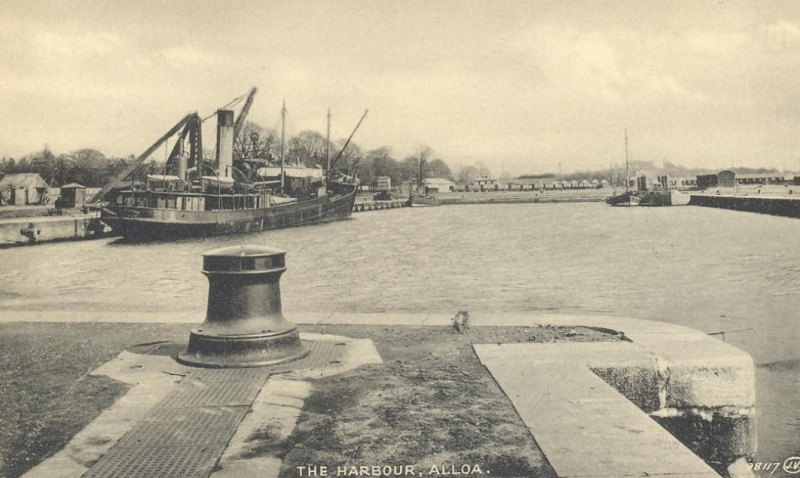
Alloa Harbour - Facebook Group - "Old Alloa Historical and Pictorial"
The Early History of Alloa as a Port
1502 King James IV paid for the provision of a ship bound for Alloa.
1558 Records of coal being carried from Alloa to Inchkeith.
1573 The Pow was used for the export of contraband and unfree goods.
1620 A charter grants the Earl of Mar the privileges of the Port and Pow of Alloa. (This does not imply the existence of a built harbour.)
1655 The reference to the 'herberie' was probably an artificial structure.
1685 The expression Port and Shore implies that vessels had at that time an improved foreshore.
1710 John Erskine Earl of Mar obtains Customs House for Alloa.
1713 Alloa constituted as a Port (member of the port of Bo'ness).
1755 Roy's map marks a pier North West of the Pow with a sluicing pond in the Pow a shorter distance higher up.
1756 Quay wall revised one foot above water mark. A quay fronting on the river west of the Pow.
1757 Addition of a quay 265 feet long on the north bank.
1761 Another quay 118 feet long linking up the two already existing.
1766 Construction of wagonways from the collieries.
1772 A commodious harbour existed.
1791 Widening of the Pow to 70 feet.
1815 Alloa constituted as an independent port.
1892 The Trustees of the Harbour sold out to North British Railway and then to North British Transport Company.
1936 Kincardine Bridge opens - road transport becomes more popular
Mid-1960's One ship a week is using the port
1970 The port closes.
Coal
The trade through the port grew dramatically once coal began to be mined in the area. In 1710, the Custom House that oversaw all the upper Forth ports was built in Alloa. The Earl of Mar made additions to the quay in 1757 and 1761. By that time, there were over 100 brigantines and sloops registered at Alloa. With the decline in tobacco trade after 1783, the coal trade became more and more important. The 'Charlotte' and the 'Nelly and Katy' were two of the sailing ships which carried coal as far afield as America. Ships delivered pit props for the coal mines regularly.
In 1766 the Alloa wagonway was established between the collieries and the harbour as it was the most efficient way to transport the coal such a distance to the boats. It was single track with several passing loops with the wagons pulled by horses.
By the mid 1800s, 2,000 vessels were using the docks at Alloa, and 175,000 tonnes of coal were exported each year. Meanwhile, ships of up to 100ft were also being built at Alloa.
Smuggling
In the early 18th century, smuggling was regarded as an excusable offence and the law was not strictly applied. The English customs laws which were applied to Scotland after the 1707 Act of Union were not respected by Scottish people - though banned as imports, the luxuries of life found their way to Alloa.
Cargoes from Holland of wine, spirits, fruits, muslins, silks and velvet - being shipped to Scandinavia, were often partly unloaded at Alloa, Airth and Elphinstone (Dunmore) and the remainder carried on to Norway or Sweden. The upper classes, if not directly involved in smuggling, were known to aid and abet the smugglers.
The Tobacco Trade
Much of the mid-18th century prosperity was because Glasgow's rich tobacco merchants established large warehouses in the town. It was the nearest east coast port to the city, and they made their profits from the re-export of their products to Holland. The Dutch could not buy tobacco direct from the British colonies in America because of the strict navigation laws.
After the union of the Scottish and English parliaments in 1707, Glasgow merchants could trade with America. Tobacco was shipped to Glasgow then brought overland on packhorses to Alloa to be taken by sea to Holland and other countries in Europe. For example, in 1720, the 'Griffin' left Alloa with 3,373 lbs of tobacco for Bergen in Norway.
Some of it was held to manufacture into cigars and snuff by John and George Pearson at their Snuff and Tobacco Mill at Jellyholm Brae near Gartmorn Dam - its Alloa Pigtail was a popular tobacco. But most of the bales were loaded on to sailing ships in the harbour and carried to the Low Countries where the Dutch preferred to process it themselves. From 1783 however, the Dutch cigar makers could buy direct from American growers, the American Wars of Independence having set the colonies free. The Glasgow tobacco barons and Alloa consequently lost this lucrative part of their trade.
Alloa's old links with Glasgow received a further blow in 1790 when Scotland's first overland waterway - the 35 mile long Forth and Clyde Canal - provided the city with a direct link with the rapidly growing port of Grangemouth where the canal entered the Firth.
In 1838, 1250 ships were cleared from Alloa taking over 80,000 tons of coal. So, despite the tobacco trade and canal setbacks, Alloa remained busy with coal exporting, cargoes for the local factories, and the steadily increasing import of pit props for the area's coal mines.
In 1861 it was decided to build a large new dock basin, and when it was completed two years later, it was 450 feet long, 137 feet broad, 24 feet deep and had a fifty-foot entry gate. At this time a dry dock for ship repairing was also constructed.
River Front
During the last two decades of the 19th century and the beginning of the 20th, the river front was the busiest part of the town. The dock was filled with vessels and others were moored outside awaiting their turn to enter. Ships were sometimes moored three abreast at South Alloa, while others lay at Kincardine waiting to come upstream. In the 1850's the shore was a great attraction for young people. It was the custom to go to the Shore "to see the boats gaun away." The sailing ships generally made two voyages in the year and lay up all winter. In early spring they would start off again. In the Alloa area all kinds of industry flourished - sawmills; carpenters; rope works; blacksmiths; coal mining; glass making; brick works; engineering; ship-building and the gas works.
Ferries
The Craigward Ferry Pier at Alloa and adjacent properties on both sides of the river, changed ownership in 1885 with the Caledonian Railway Company's completion of the Alloa Railway Bridge. Alexander McLeod became the lessee of the ferry and both piers, building up this business and expanding into tugboats and lighters. His first new ferry, the 'Lord Erskine' was built in 1886. It was replaced in 1905 by the 'Hope', a twin screw shallow draft steamer. The ferry was worked from Alloa to South Alloa until the Kincardine Bridge was opened in 1936.
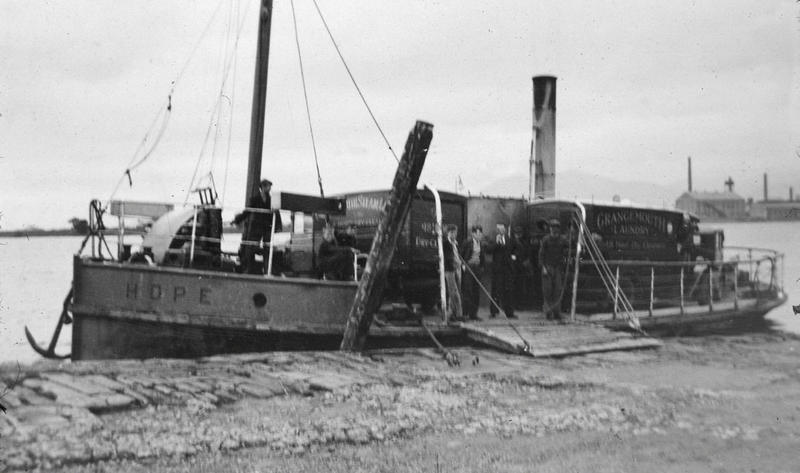
Hope - Alloa Ferry - Built 1905 by Mackay Bros. Alloa
Steamers
The river steamers, some owned and managed from Alloa were the principal means of transport for passengers before the railway, especially to Edinburgh. There were regular sailings to Stirling, Bo'ness, Granton, Leith, and Broughty Ferry. The early Prince of Wales and the Prince Albert were replaced by the Victoria. Mr Galloway of Leith owned the paddle-steamers, Edinburgh Castle, Stirling Castle, Lord Morton and Lord Aberdour.
Usually about once a fortnight there were pleasure sailings from Stirling to Leith. Two paddle-steamers, Edinburgh Castle and Stirling Castle were fitted with telescopic funnels and folding masts in order to pass under the Alloa Railway Bridge. The sail up and down the windings was perhaps the finest stage of the journey, with the Ochil Hills and Ben Lomond to the north, to the south the Denny Hills.
Alloa Railway Bridge
This swing rail bridge across the Forth was completed in 1885. The rail bridge temporarily put the ferries out of business, but they resumed operation in 1901, and a vehicle ferry was introduced on the route from 1924. Navigating it could be hazardous. In 1904, a small schooner being towed to Stirling collided with a span support on the north side. A similar accident occurred in 1927 when an old destroyer which had been lying in the mud near South Alloa waiting to be broken up, floated on a strong tide and drifted against the bridge. On both occasions the bridge was repaired by Sir William Arrol and Company. The bridge was partially dismantled after the Alloa Railway Station closed in 1968. The columns still stand but the bridge deck itself has been removed.
 |
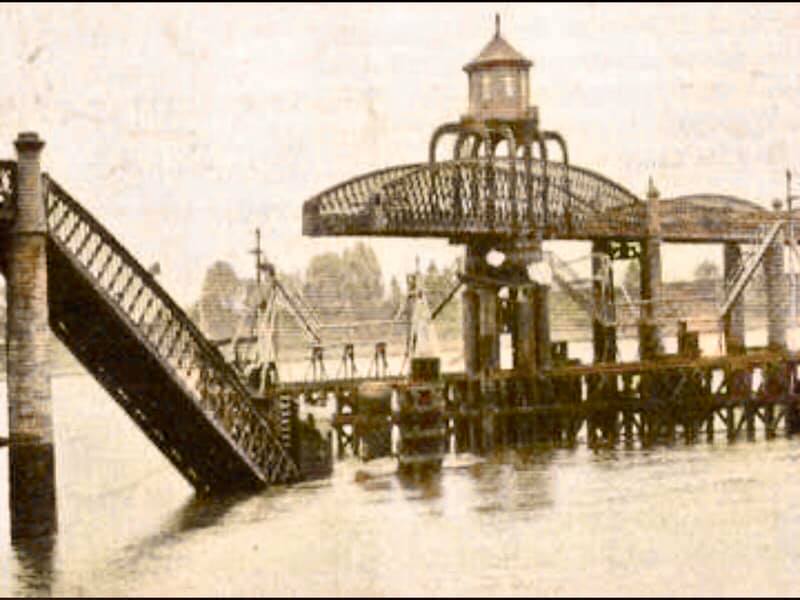 |
The Decline of the Port
Although the port was almost done by the 1950's, there were other earlier causes which contributed to the decline of the port. In November 1914, the government stopped all traffic and commerce on the Forth because of the danger of information leaking to enemy countries. From that date the export and import trade on the Forth only partly recovered.
It was also becoming possible to transport goods by motor vehicles from the larger ports. Owners of foreign vessels began to feel there was no point in navigating the upper reaches of the river when they could find better facilities at Grangemouth.
The vehicle ferries finally ceased operation in 1939, though traffic had been in steep decline since the opening of the Kincardine Bridge to the east in 1936. By the 1960's the port of Alloa could not compete with modern handling techniques at ports like Grangemouth, and even its shipbreaking operations were too far upriver to be reached by the larger ships then being scrapped.
The port closed in 1970 and almost all of the infrastructure has since been redeveloped.
Kincardine Bridge
The opening of Kincardine Bridge in 1936 improved road communication from Alloa to Grangemouth, and it became faster for ships to discharge at Grangemouth and have their cargoes carried by road to Alloa's factories. After 1945 attempts were made to modernise the port at Alloa including the electrification of the dock gates, but apart from specialist cargoes it could not compete with Grangemouth.
At the beginning of the 1960's the British Transport Commission officially closed Alloa to navigation, a blow it would not recover from.
The Glasgow Wharf
In 1992 Kerrs Chartering Ltd. of Glasgow, were looking to re-open the (at the time undeveloped) old Glasgow Wharf at Alloa, having leased the facility from Christiani & Neilsen, and made repairs. They had proposed using specialised vessels which could reach inland destinations without trans-shipping, allowing faster transit times. Over-crowded motorways and higher fuel costs were once again highlighting the Port of Alloa's original advantage - its position on the upper reaches of the River Forth.
However, reports of the time suggested that Kerrs had several points of disagreement with Forth Ports, who provide navigation and pilotage on the Forth. One of these was provision of navigation equipment and services beyond the Kincardine Bridge, with reports stating that Forth Ports wished to make Kerrs pay for the equipment. When Kerrs refused to pay, Forth Ports banned all navigation upstream of Kincardine bridge once more, ending any further chance of returning the Port of Alloa to a working facility. The area has since been redeveloped with only a small section of dock remaining as a reminder of the past.
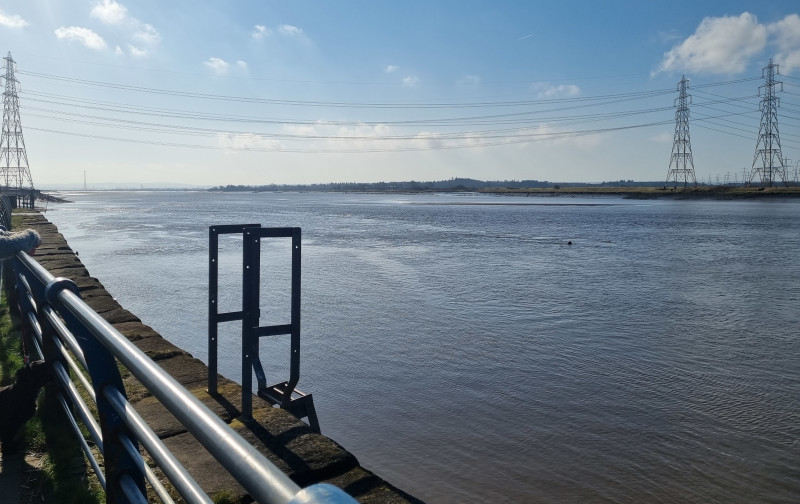 |
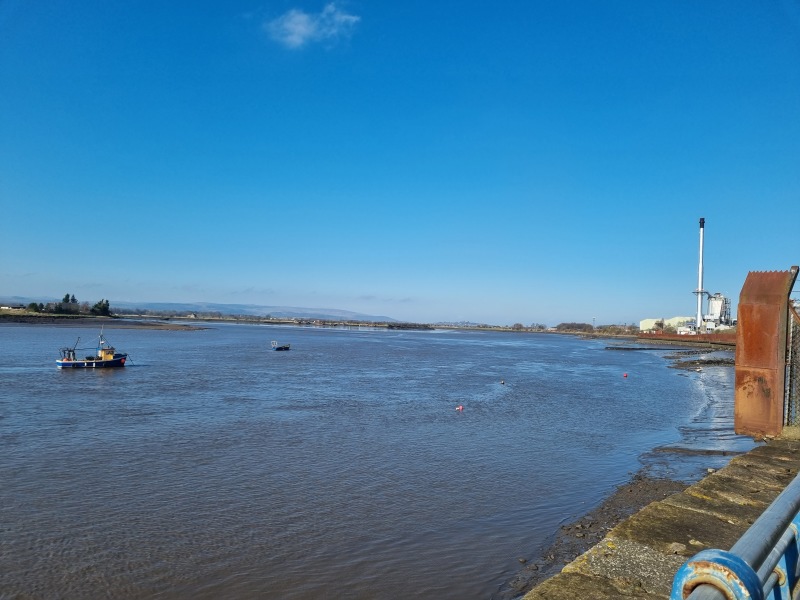 |
Pictures from the remnants of Alloa's Port - March 2022
References:
Alloa, The Port, Ships and Shipbuilding by Jannette Archibald
The Herald - "old port in a new storm"
